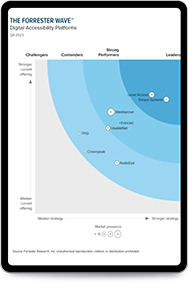Assistive technology
Feb 13, 2024
People with disabilities navigate the internet in various ways. While some may use tools that provide audible interpretation of on-screen content, others may rely on tools that enable them to navigate a web experience without a touch or track pad. These tools are called assistive technologies.
What is assistive technology?
Assistive technology is an umbrella term for a wide range of tools, devices, software, and equipment that enhance learning, working, and daily life for people with disabilities and others with accessibility needs.
Assistive technology comes in many forms, from wheelchairs to hearing aids to prostheses. But when it comes to digital accessibility, assistive technology refers to the tools and software that enable people with disabilities to access and interact with web platforms, digital applications, and devices. And in today’s world, most online platforms—desktop and mobile—come with built-in assistive technology.
However, assistive technology is only successful if the website, app, or platform’s content is coded properly for accessibility. Proper coding, like implementing semantic HTML or providing alternative text for images, ensures that people who use assistive technology can comprehend the content effectively.
When done right, assistive technology in the digital world ensures people with various disabilities—such as motor, visual, auditory, and cognitive disabilities—can use and benefit from technology to its full capacity.
What are different types of assistive technology?
Several assistive technologies exist to meet the diverse needs of people with disabilities, which is crucial for making online content and interactions accessible to these users. The most common forms of assistive technology are:
Screen readers
Screen reading software converts on-screen text and interactive elements into speech, enabling people with visual disabilities to navigate the web. The playback speed can be set by the user, and they can use specific commands to allow them to skip from heading to heading, click links, and understand visual elements on a web screen or page. Apple’s iOS Voiceover is an example of a built-in screen reader.
Braille displays
A braille display translates digital text and other web elements, such as graphs, into braille, enabling blind or deaf-blind people to interpret web content through touch. Screen readers also have the capability of converting on-screen elements into braille format.
Screen magnifiers
Screen magnifying tools provide a range of magnification levels for on-screen content and computer pointers, making web interactions easier for people with low or no vision. Some screen magnifiers also provide text-to-speech functions, as well as options to invert colors.
Reading assistants
For people with low vision or who have difficulty understanding text content, reading assistants can change the presentation of content and provide other functionality to make it more readable. For example, customizing fonts, text size, and color is possible with this software.
Speech recognition software
Speech recognition software allows a user to navigate, type, and interact with a website using their voice. This technology converts spoken words into text, helping people who have difficulty typing navigate the web. In some cases, this software can be used to issue commands to operate a computer. Windows Speech Recognition and Dragon are examples of this software.
Keyboard navigation functionality
People with mobility disabilities often have trouble gripping a standard mouse or using a touchpad. Instead, they may use keyboard-only navigation to navigate through websites, typically by using the tab key to jump from one item such as a link, header, or list item, to the next.
Alternative keyboards
People with mobility or cognitive disabilities may prefer an alternative keyboard, such as a larger keyboard, a one-handed keyboard, a Bluetooth-enabled keyboard, or an on-screen keyboard, to help them interact with web content. These keyboards enhance accessibility and offer benefits by catering to the various needs and preferences beyond standard keyboard designs.
Eye tracking devices
Like there are alternative keyboards, there are also alternatives to mouses and pointer devices. Eye tracking devices enable the use of technology by people with mobility disabilities. Instead of using a mouse, this device tracks eye to determine where the person is focusing and what they want to click on.
Who benefits from assistive technology?
Assistive technologies extend far beyond functionality; they have paved the way for increased independence among people with disabilities, empowering them to engage with the digital world on their own terms.
Without assistive technology, people with disabilities—such as people that are blind or people with a mobility disability—would be excluded from the online world. Whether it’s a screen reader or alternate keyboard, assistive technologies ensure that they can access digital spaces and perform everyday tasks on web and mobile platforms.
However, while people with disabilities are the main beneficiaries, assistive technologies can also benefit those with temporary needs. For example, a broken arm may prevent someone from using a mouse, requiring them to utilize keyboard-only navigation. Additionally, someone in a situational challenge, such as traffic, may want to use speech-to-text to send a message.
In short, assistive technology benefits everyone. And at the end of the day, it’s influence extends beyond its intended audience, fostering a more accessible digital landscape for everyone.
